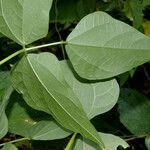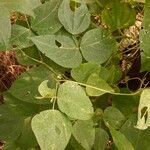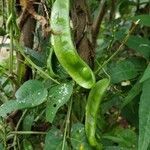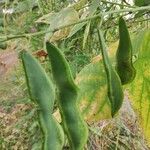Perennial or biennial climber or sometimes subshrubby, 1–4·5 m. long.. Stems glabrous or pubescent.. Leaflets 3, the laterals oblique, ovate to lanceolate or narrowly rhombic, 3–15 cm. long, 1·2–10 cm. wide, acute or acuminate, ± rounded at the base, sparsely pubescent or glabrous; petiole 1·5–19 cm. long; rhachis 0·7–5 cm. long; petiolules 3–5 mm. long; stipules ovate-lanceolate, persistent, 2–3·5 mm. long.. Inflorescences lax, few–several-flowered; rhachis 1–7 cm. long; peduncle 1·5–30 cm. long; pedicels 5–10 mm. long; bracts persistent, lanceolate, 1·5 mm. long; bracteoles persistent, elliptic or ovate, 1·5–2 mm. long, 0·5–1 mm. wide, (1–)3–7-nerved.. Calyx puberulous; tube 1·5–2·5 mm. long; lobes broadly triangular, 5–8 mm. long, the upper pair joined to form an emarginate lip.. Standard white, yellowish-buff or pale rose, rounded or oblate-oblong, 5–7 mm. long, 5–8·5 mm. wide, emarginate, sparsely pubescent or glabrous outside; keel 1–1·4 cm. long, spirally incurved for 11/2 turns.. Pods oblong-falcate or oblong-oblanceolate, 3–4-seeded, (4·5–)5–10·5(–13) cm. long, 1·2–2·2(–2·5) cm. wide, compressed, apiculate at the apex, glabrous or pubescent.. Seeds very variable in colour, mostly white or purple, reniform or rhomboid-reniform, compressed, longest dimension 1–1·5 cm., shorter dimension 0·8–1·2 cm., 5–5·5 mm. thick; hilum whitish, 2·5–4 mm. long.. Fig. 95, p. 616.
Annual or perennial herbs, twining. Stems pubescent or glabrous. Stipules triangular, 2-3.5 mm; leaflets ovate, 5-12 × 3-9 cm, lateral ones often oblique, sparsely pubescent along veins or glabrous on both surfaces, base rounded or broadly cuneate, apex acuminate or acute. Racemes axillary, 8-20 cm. Bracteoles elliptic, shorter than calyx tube, with 3 elevated veins when dry. Calyx campanulate, 2-3 mm, pubescent. Corolla white, yellowish, or reddish; standard 7-10 × 5-8.5 mm, apex emarginate; wings obovate; keel apex twisted for 1-2 turns. Ovary pubescent. Legumes falcate-oblong, 5-10 × 1.5-2.5 cm, compressed, apex beaked, 2-4-seeded. Seeds white, purple, or other color, subrhombic or reniform, 12-13 × 8.5-9.5 mm. Fl. spring to summer.
Climbing annual to biennial herb; stems moderately hairy, particularly in upper parts. Lvs hairy on petiole, petiolules and midveins; leaflets broadly ovate to deltate, acute, entire, 40-70-(100) mm long; stipules ovate-triangular, c. 2 mm long; stipels narrower than stipules, 1.5-2 mm long. Infl. racemose, lvs, 2-6-(10)-flowered, with many small bracteoles. Pedicel ± = fls. Calyx sparsely hairy; calyx teeth much < tube. Corolla white, 8-15 mm long; beak of keel forming c. 2 turns of a spiral. Pod glabrous, brown, boat-shaped, 2-4-seeded, 40-100 mm long; seeds large, variable in shape and colour.
A perennial climbing bean. It is often a tall vigorously climbing plant which can keep growing for some years. The leaves are slightly rounded at the base and pointed at the tip. The flower is white or yellow. The keel of the flower is twisted which helps tell the difference between this bean and Lablab bean. The pods are long (10 cm), flattened and curved and have 3-4 seeds which are very variable in colour. The seeds are large. The seeds have a short round hilum where the seed is attached to the pod. The seeds also have lines going out from this point across the bean seed.
Leaflets 3, 3–15 × 1.2–10 cm, the laterals oblique, ovate to lanceolate or narrowly rhombic, acute or acuminate, ± rounded at the base, sparsely pubescent or glabrous; petiole 1.5–19 cm long; rhachis 0.7–5 cm long; petiolules 3–5 mm long; stipules 2–3.5 mm long, ovate-lanceolate, persistent.
Inflorescences lax, few–several-flowered; rhachis 1–7 cm long; peduncle 1.5–30 cm long; pedicels 5–10 mm long; bracts persistent, 1.5 mm long, lanceolate; bracteoles persistent, 1.5–2 × 0.5–1 mm, elliptic or ovate, (1)3–7-nerved.
Standard white, yellowish-buff or pale rose, 5–7 × 5–8.5 mm, rounded or oblate-oblong, emarginate, sparsely pubescent or glabrous outside; keel 1–1.4 cm long, spirally incurved for 11/2 turns.
Seeds very variable in colour, mostly white or purple, 10–15 × 8–12 × 5–5.5 mm, reniform or rhomboid-reniform, compressed; hilum whitish, 2.5–4 mm long
Pods (4.5)5–10.5(13) × 1.2–2.2(2.5) cm, oblong-falcate or oblong-oblanceolate, 3–4-seeded, compressed, apiculate at the apex, glabrous or pubescent.
Calyx puberulous; tube 1.5–2.5 mm long; lobes 5–8 mm long, broadly triangular, the upper pair joined to form an emarginate lip.
Perennial or biennial climber, sometimes subshrubby, 1–4.5 m long.
A rank-growing twiner, biennial, with half-woody stems
Rather small greenish-white or bluish flowers.
Stems glabrous or pubescent.





